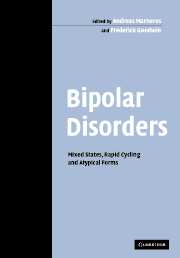Book contents
- Frontmatter
- Contents
- List of contributors
- Preface
- 1 Bipolar disorders beyond major depression and euphoric mania
- 2 Emerging concepts of mixed states: a longitudinal perspective
- 3 Rapid-cycling bipolar disorder
- 4 Bipolar I and bipolar II: a dichotomy?
- 5 Recurrent brief depression as an indicator of severe mood disorders
- 6 Atypical depression and its relation to bipolar spectrum
- 7 Agitated depression: spontaneous and induced
- 8 Schizoaffective mixed states
- 9 Acute and transient psychotic disorder: an atypical bipolar disorder?
- 10 Bipolar disorder in children and adolescents
- 11 Atypical features of bipolarity in old age
- 12 Comorbidity in mixed states and rapid-cycling forms of bipolar disorders
- 13 Challenges in the genetics of bipolar disorder
- 14 Biological aspects of rapid-cycling and mixed states
- 15 The treatment of bipolar mixed states
- 16 The use of atypical antipsychotic agents in the treatment of diagnostic subgroups of bipolar disorder: mixed and pure states, psychotic and non-psychotic
- 17 Investigational strategies: treatment of rapid cycling, mixed episodes, and atypical bipolar mood disorder
- Index
- References
17 - Investigational strategies: treatment of rapid cycling, mixed episodes, and atypical bipolar mood disorder
Published online by Cambridge University Press: 10 August 2009
- Frontmatter
- Contents
- List of contributors
- Preface
- 1 Bipolar disorders beyond major depression and euphoric mania
- 2 Emerging concepts of mixed states: a longitudinal perspective
- 3 Rapid-cycling bipolar disorder
- 4 Bipolar I and bipolar II: a dichotomy?
- 5 Recurrent brief depression as an indicator of severe mood disorders
- 6 Atypical depression and its relation to bipolar spectrum
- 7 Agitated depression: spontaneous and induced
- 8 Schizoaffective mixed states
- 9 Acute and transient psychotic disorder: an atypical bipolar disorder?
- 10 Bipolar disorder in children and adolescents
- 11 Atypical features of bipolarity in old age
- 12 Comorbidity in mixed states and rapid-cycling forms of bipolar disorders
- 13 Challenges in the genetics of bipolar disorder
- 14 Biological aspects of rapid-cycling and mixed states
- 15 The treatment of bipolar mixed states
- 16 The use of atypical antipsychotic agents in the treatment of diagnostic subgroups of bipolar disorder: mixed and pure states, psychotic and non-psychotic
- 17 Investigational strategies: treatment of rapid cycling, mixed episodes, and atypical bipolar mood disorder
- Index
- References
Summary
The psychiatric literature includes relatively few adequately powered controlled double-blind clinical trials reporting results for bipolar disorders. The majority of these randomized clinical trials report results for treatment of acute mania in hospitalized bipolar I (BP-I) patients. The majority of bipolar patients are, however, not BP-I and manic states are relatively infrequent. Why are there so few published controlled treatment studies dealing with common clinical problems like rapid cycling, mixed episodes, and atypical bipolar disorder?
Rapid cycling, mixed episodes, and atypical bipolar mood disorder each challenge clinical researchers in distinctly different ways. This chapter explores the issues as they relate to study design in general and offers suggestions for study methodology.
The first consideration is the conceptual dissimilarity of the terms rapid cycling, mixed episodes, and atypical bipolar disorder. These terms correspond to three distinct organizational levels used in the Diagnostic and Statistical Manual of Mental Disorders, 4th edn (DSM-IV) mood-disorder nosology and represent the concepts of course specifier, acute episode, and subtype of bipolar (American Psychiatric Association, 1994). Study designs for each require attention to sample selection, outcome measures, and an analysis plan matched to the appropriate level in the organizational hierarchy of the DSM-IV mood-disorder classification.
Difficulties in conducting clinical trials for atypical bipolar disorder
The DSM-IV bipolar mood disorder category is subtyped into BP-I, BP-II, cyclothymia, and bipolar disorder not otherwise specified. The latter encompasses all forms of “atypical bipolar disorder” which do not meet criteria for one of the three defined subtypes.
Keywords
- Type
- Chapter
- Information
- Bipolar DisordersMixed States, Rapid Cycling and Atypical Forms, pp. 369 - 385Publisher: Cambridge University PressPrint publication year: 2005
References
- 1
- Cited by

